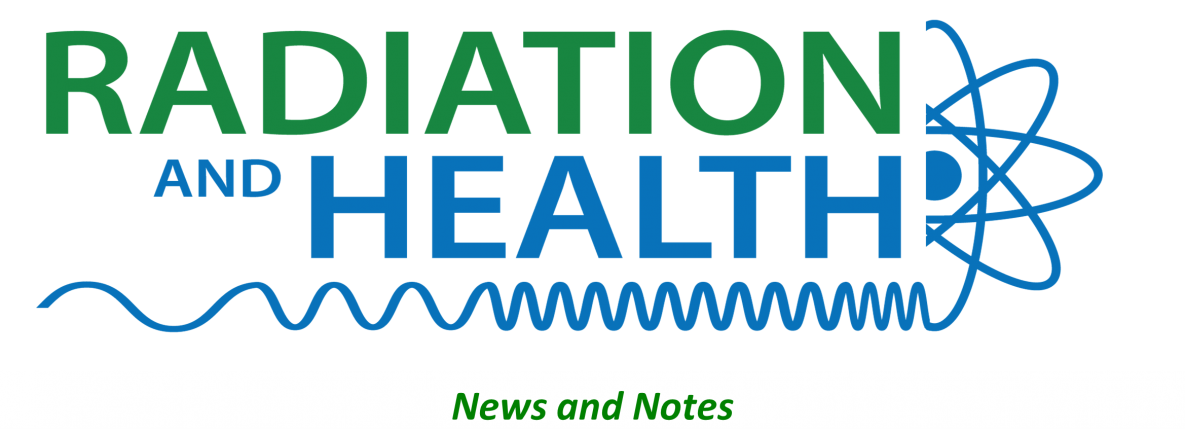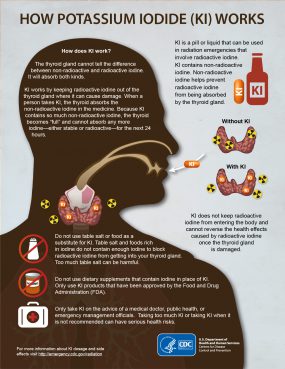Radiation and Health Newsletter – July 2022

Recent news stories show increased interest and purchases of potassium iodide (KI) to protect against a radiation emergency. But is KI really the anti-radiation pill that some people claim? Will it help Americans in a potential radiation emergency? Two CDC radiation experts, Dr. Armin Ansari and Dr. Art Chang, answer questions about KI and how it does and does not help in a radiation emergency.

Armin Ansari, Ph.D.
Radiation Studies Section, CDC
Dr. Ansari (Health Physicist, Expert in Radiation Protection and Health): In recent months, the war in Ukraine raised some concerns about several potential types of radiation emergencies that could occur:
- Damage to a nuclear power plant, including the Chernobyl facility, or a spent nuclear fuel facility that could result in a release of radiation or radioactive material (contamination) to the surrounding area
- Use of tactical (smaller) nuclear weapons in battle
- Theft of unsecured radioactive material to make a radiological dispersal device, commonly called a dirty bomb
Many people have heard of KI as an anti-radiation medicine and want to purchase it for protection, but unfortunately do not understand the limits of KI’s abilities to protect against the health effects of radiation.
Fortunately, the best protection in a radiation emergency is already available. In a radiation emergency, your best protection is to Get Inside, Stay Inside, and Stay Tuned for more information.
If the types of radiation emergencies listed above were to occur in Ukraine, however disastrous they may be to the people living in that region, it is highly unlikely that it could pose any health risks to people in the United States.

Arthur Chang, M.D., M.S.
Division of Environmental Health Science and Practice, CDC
Dr. Chang (Medical Officer and Expert in Medical Treatments for Radiation): KI and radioactive iodine are both types of iodine. They are both absorbed by the thyroid. The thyroid is a gland in the neck that plays an important role in many body functions. For KI to work, a person must take it before or shortly after exposure to radioactive iodine. When a person takes the right amount of KI at the right time, it can help block the thyroid from absorbing radioactive iodine. This happens because the thyroid has already absorbed the KI, and there is no room to absorb the radioactive iodine. Think of filling a jar with blue marbles. If you then pour green marbles over the jar, there will not be room and they will just spill out. In this example, the jar is the thyroid, the blue marbles are the KI, and the green marbles are the radioactive iodine.
CDC has two short videos that show this on its website at Facts About Potassium Iodide (KI) | CDC.
In some radiation emergencies, usually nuclear power plant accidents, radioactive iodine may be released into the environment and enter the body through breathing or eating. This is known as internal contamination. When the thyroid absorbs high levels of radioactive iodine, it can increase the risk of thyroid cancer in infants, children, and young adults many years after exposure.
Dr. Ansari: In some radiation emergencies, such as a nuclear power plant emergency, officials may recommend that you take KI if you are near the incident. If they do this, they likely will provide it for people who need it. But you should take KI only if directed by public health or emergency response officials or a healthcare provider. KI can cause harmful health effects, and it is helpful only in specific situations for certain groups of people.
Dr. Ansari: In a nuclear detonation, the biggest threat to the health of most people outside the blast zone is the direct radiation exposure from radioactive fallout. Fallout is made up of hundreds of types of radioactive materials. KI protects only your thyroid after breathing or ingesting something that is contaminated with high amounts of radioactive iodine. The risk from doing that is extremely small compared to the risk from other radioactive materials that can cause harm just by coming in contact with the surface of your body. KI does not protect against this threat.
The best protection in a nuclear detonation is to avoid radiation exposure by getting inside, staying inside, and staying tuned for instructions from local officials.
Dr. Chang: KI can have harmful health effects and can cause adverse effects such as allergic reactions. The risk of harm from KI outweighs its potential benefit when it is not taken exactly as directed by a medical professional or public health official. And it is important to know that taking more than the dose you are directed does not offer more protection and can be dangerous.
Harmful health effects may include the following:
- Gastrointestinal (stomach) upset, rashes, and inflammation of the salivary glands
- Allergic reaction
- The development of hypothyroidism in infants less than one month old who receive more than one dose of KI (Hypothyroidism is a condition in which the thyroid doesn’t produce enough hormones.)
Dr. Chang: Iodine is found in other substances, but CDC does not recommend the use of iodized table salt, kelp, or other foods as a substitute for KI. They do not contain the right dose of iodine that can block the thyroid from absorbing radioactive iodine and eating large amounts could be harmful.
If you are told to take KI, use only KI medications that have been approved by the Food and Drug Administration (FDA). Dietary supplements that contain iodine may not work to protect the thyroid and can hurt you.
There is no anti-radiation pill, and every type of radiation is different. The best way to protect yourself is to limit your exposure to radiation.
Dr. Ansari: We have much more information about KI and other related topics, including educational videos and infographics, on CDC’s Radiation Emergencies website. Please visit the site to learn about how best to prepare for and protect yourself in a radiation emergency.
Sheltering in a Radiation Emergency
This brief animated video describes what is meant when officials tell people to “shelter in place” in a radiation emergency. It also explains how this may be different from “stay at home” guidance for other emergencies.
What Do Radiation Contamination and Exposure Mean?
This brief animated video describes the concepts of radiation exposure and contamination with radioactive materials, and how these terms are used differently than in an infectious disease emergency.
Potassium Iodide (KI) and Radiation Emergencies
This brief animated video describes the role of KI in a radiation emergency and its benefits and limitations.
These videos, along with a number of other videos on radiation emergency topics, are located on our Radiation Emergencies website at Educational Videos — Protective Actions, Pharmaceutical Countermeasures, and Health Effects.
In addition, two webpages on the Radiation Emergencies site have been updated with additional information:
How to Feed Your Baby in a Radiation Emergency
In a radiation emergency, mothers who are in the affected area might be exposed to radiation and may also be internally contaminated if they eat, drink, or breathe in radioactive material. This page provides information to people who are breastfeeding about what to do in a radiation emergency.
Potassium Iodide (KI)
KI is a protective measure that is useful in limited situations. This page provides updated information about this important topic.
CDC also has updated its Guidelines for Handling Decedents Contaminated with Radioactive Materials (cdc.gov). In the 15 years since the first edition of the guidelines was published, CDC and its partners have made considerable advances in the field of public health preparedness and radiation emergency response. This second edition builds on previous works and incorporates new information that federal, state, and local officials can use to advance and refine their mass fatality planning efforts.
And finally, CDC has two new risk communication tip sheets for radiation emergencies. The Crisis and Emergency Risk Communication (CERC): Radiation Emergencies expanded and one-page documents serve as guides to applying the six principles of CDC’s CERC to radiation emergency communications.
Although summer is the time for fun in the sun, it’s important to plan ahead to ensure you are able to stay sun-safe during your time outdoors.

Ultraviolet (UV) radiation is a form of non-ionizing radiation that is emitted by the sun and artificial sources, including:
- Tanning beds
- Mercury vapor lighting (often found in stadiums and school gyms)
- Some halogen, fluorescent, and incandescent lights
- Some types of lasers
What are the different types of UV radiation rays?
UV radiation is classified into three primary types: ultraviolet A (UVA), ultraviolet B (UVB), and ultraviolet C (UVC). All of the UVC and most of the UVB radiation is absorbed by the earth’s ozone layer, so nearly all of the ultraviolet radiation received on Earth is UVA. UVA and UVB radiation can both affect health. Even though UVA radiation is weaker than UVB, it penetrates deeper into the skin and is more constant throughout the year. Since UVC radiation is absorbed by the earth’s ozone layer, it does not pose as much of a risk.
Health Effects of UV Radiation
Overexposure to UV radiation can lead to serious health issues, including skin cancer. Skin cancer is the most common cancer in the United States. The two most common types of skin cancer are basal cell cancer and squamous cell cancer. Typically, they form on the head, face, neck, hands, and arms because these body parts are the most exposed to UV radiation. Most cases of melanoma, the third most common type of skin cancer, are also caused by exposure to UV radiation. Melanoma is more likely to spread to other parts of the body, including vital organs, which can make it more difficult to treat and sometimes deadly.
Benefits of UV
Beneficial effects of UV radiation include the production of vitamin D, a vitamin essential to human health. Vitamin D helps the body absorb calcium and phosphorus from food and assists bone development. According to the World Health Organization (WHO), 5 to 15 minutes of sun exposure 2 to 3 times a week provides enough exposure for most people. However, this varies depending on a person’s skin type, health conditions, age, geographic location, time of day, time of year, and weather conditions. There is no known level of UV exposure that would increase vitamin D levels without also increasing skin cancer risk. Vitamin D can be obtained safely through food and dietary supplements without the risks associated with overexposure to UV.
Risks of UV
- Sunburn is a sign of short-term overexposure; over time, UV overexposure contributes to premature skin aging and increases a person’s skin cancer risk.
- UV exposure can increase skin and eye sensitivity if you are taking certain oral and topical medicines, such as antibiotics, birth control pills, and benzoyl peroxide products; some cosmetics can have this effect too.
- UV exposure increases the risk of potentially blinding eye diseases if eye protection is not used and contributes to the development of cataracts.
Anyone can get skin cancer, but it is more common in certain groups:
- People who spend a lot of time in the sun or have been sunburned
- Those who have light-color skin, hair, and eyes
- People who have a family history of skin cancer
- Those who are over age 50
It is important to protect young children from UV exposure because their skin may be more sensitive, and they are still growing and developing new cells. However, research findings suggest that sunburns even later in life contribute to a person’s skin cancer risk, making sun-safety important for people of all ages.

To protect yourself from UV radiation, do the following:
- Stay in the shade, especially during midday hours. UV rays tend to be strongest from 10 a.m. to 4 p.m.
- Wear clothes that cover your arms and legs.
- Wear a wide brim hat to shade your face, head, ears, and neck.
- Wear wraparound sunglasses that block both UVA and UVB rays.
- Use a broad-spectrum sunscreen with sun protection factor (SPF) 15 or higher, for both UVA and UVB protection.
- Avoid indoor tanning.
Visit CDC’s Radiation and Your Health and Skin Cancer | CDC websites for more information.
Please share this resource with your colleagues, partners, and networks.
Did you receive this newsletter from someone else?
Sign up for CDC’s Radiation and Health newsletter to get the latest updates, activities, and news about radiation and health and radiation emergency preparedness.
